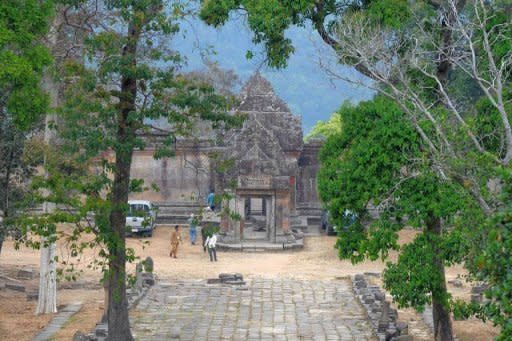Six dead in Thai-Cambodian border clash
Thai and Cambodian troops exchanged gunfire and artillery shells on Friday, leaving six dead in a clash that shattered a two-month lull in tensions along their disputed border. It was the first serious outbreak of hostilities since February when 10 people were killed in fighting near the 900-year-old Hindu temple Preah Vihear, prompting a UN appeal for a lasting ceasefire. Three Cambodian and three Thai soldiers were killed in Friday's clash near a different group of temples over 100 kilometres away. More than a dozen others were wounded, including three Thai troops who were said to be in critical condition. Indonesia, current chair of the Association of Southeast Asian Nations (ASEAN), called for an immediate end to the violence. Timeline of the border dispute The two sides blamed each other for the clash which broke out in the early morning and lasted for more than six hours. Thousands of villagers were evacuated on the Thai side. "Cambodian soldiers fired with assault rifles at Thailand first and... started to shell us with artillery," Thai Defence Minister General Prawit Wongsuwon told AFP. "I think Cambodia wanted to take over temples on the border," he said. Cambodia for its part accused Thai troops of entering its territory. "Thai troops crossed the border and attacked our military bases," said Cambodian defence ministry spokesman Chhum Socheat. The fighting subsided by early afternoon but "the situation remains tense," he said. Cambodian Foreign Minister Hor Namhong complained about what he described as a "deliberate act of aggression", in a letter addressed to the current UN Security Council president Nestor Osorio of Colombia. Thai artillery shells had landed 21 kilometres (13 miles) inside Cambodian territory, he said in the letter, which was released to media in Phnom Penh. The Thai-Cambodia border has never been fully demarcated, partly because it is littered with landmines left over from decades of war in Cambodia. Ties between the neighbours have been strained since Preah Vihear -- the most celebrated example of ancient Khmer architecture outside Cambodia's Angkor -- was granted UN World Heritage status in July 2008. The World Court ruled in 1962 that the temple belonged to Cambodia, but both countries claim ownership of a 4.6 square kilometre (1.8 square mile) adjacent area. Observers say the temple dispute has been used as a rallying point to stir nationalist sentiment in Thailand and Cambodia. The two countries agreed in late February to allow Indonesian observers in the area near Preah Vihear, but the Thai military has since said they are not welcome and they have yet to be deployed. In February, UN Security Council members called for "maximum restraint" by the two countries and a permanent ceasefire -- a demand echoed by the chair of the ASEAN regional bloc on Friday. "Indonesia, as current chair of ASEAN, strongly calls for the immediate cessation of hostilities between Cambodia and Thailand," Indonesian Foreign Minister Marty Natalegawa said in a statement. He said he was in contact with his Thai and Cambodian counterparts, urging the two countries to "resolve their differences through peaceful means". Cambodia has called for outside mediation to help end the standoff, but Thailand insists the dispute should be resolved through bilateral talks. Thailand recently admitted using controversial Dual Purpose Improved Conventional Munitions during the February fighting but insisted it did not classify them as cluster munitions. The arms are defined as cluster munitions by the global campaign group Cluster Munition Coalition (CMC), which condemned Thailand's use of the weapons.




